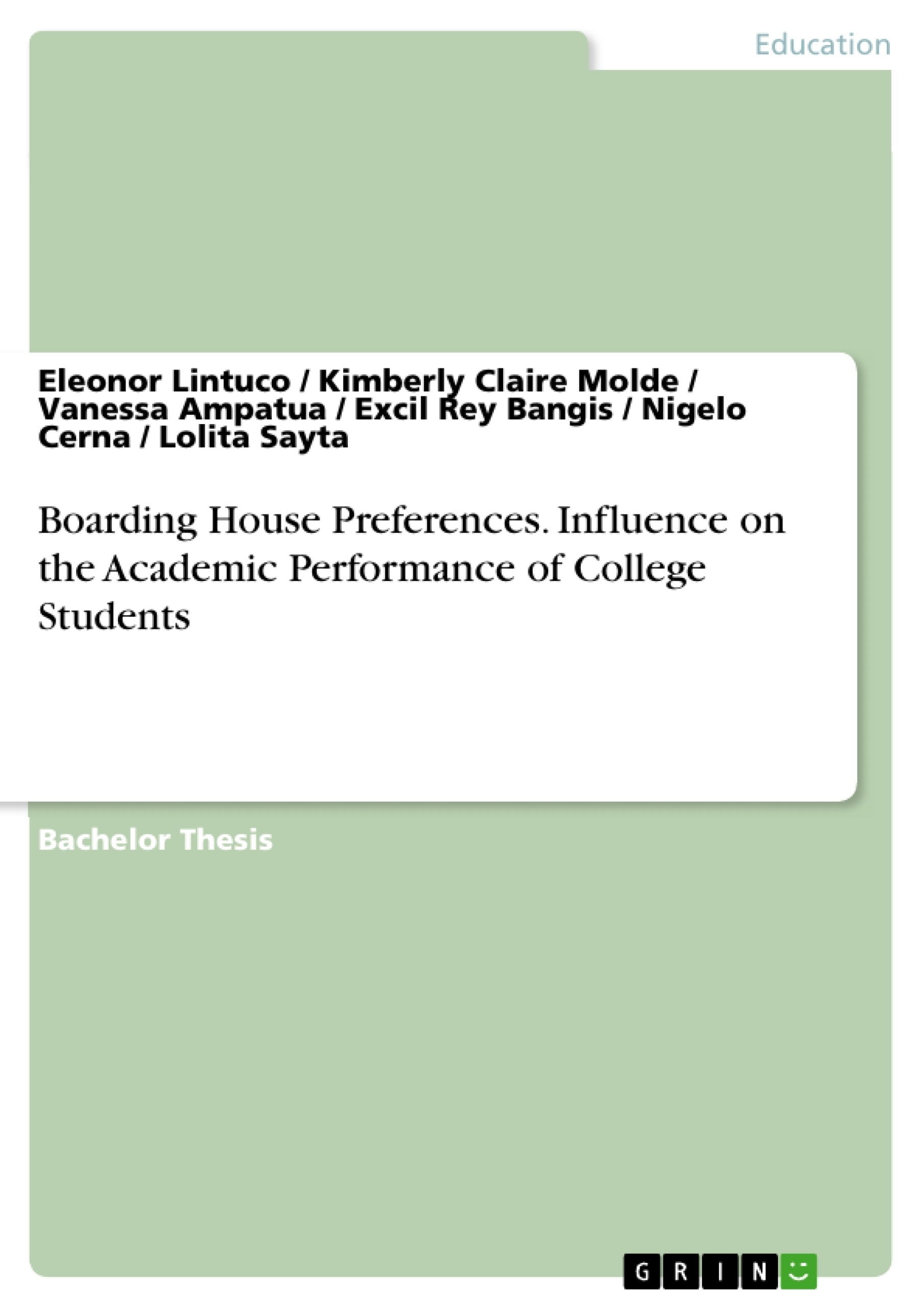This study aimed to find out the influence of boarding house preference on the academic performance of education boarding college students in San Agustin Institute of Technology. The study was conducted among the one hundred twenty education boarding college students of San Agustin Institute of Technology in Poblacion, Valencia City, Bukidnon during school year 2020-2021. This study utilized the descriptive-correlational research method using an adapted questionnaire to answer the research objectives. Frequency count, percentage, average weighted mean, Pearson r product moment correlation coefficient were used to treat the data.
Table of Contents
- Chapter 1: Introduction
- Chapter 2: Methods
- Chapter 3: Results
- Chapter 4: Discussion
Objectives and Key Themes
This study aimed to determine the influence of boarding house preferences on the academic performance of education college students at San Agustin Institute of Technology. It investigated the relationship between various aspects of boarding house living and student academic success.
- Influence of boarding house preferences on academic performance.
- Relationship between boarding house characteristics (proximity, rules, facilities) and academic achievement.
- Correlation between student demographics (allowance, parental income) and academic performance.
- Predictive power of boarding house proximity on academic performance.
- Overall student academic performance level.
Chapter Summaries
Chapter 1: Introduction: This chapter introduces the research study, focusing on the impact of boarding house preferences on the academic performance of education students at San Agustin Institute of Technology. It establishes the context of the study by highlighting the significance of understanding the factors that influence student success in higher education, particularly within the context of boarding arrangements. The chapter likely details the research problem, objectives, and hypotheses guiding the investigation.
Chapter 2: Methods: This chapter outlines the research methodology employed in the study. It describes the research design (descriptive-correlational), the sample population (120 education students at San Agustin Institute of Technology), and the data collection instruments used (an adapted questionnaire). The chapter also details the statistical techniques used to analyze the collected data, including frequency counts, percentages, average weighted means, Pearson r product-moment correlation coefficient, and regression analysis. The methods section ensures the study's rigor and reproducibility.
Chapter 3: Results: This chapter presents the findings of the study. The results section likely details the descriptive statistics regarding student demographics (weekly allowance, parental income, boarding house preferences, student status, etc.) and the correlation between various boarding house characteristics (proximity to school, house rules, landlord presence, facilities) and academic performance. Key findings related to the significant relationships discovered and the predictive value of proximity to the school would be presented using statistical measures.
Chapter 4: Discussion: This chapter interprets the results of the study in relation to existing literature and theory. It analyzes the significant correlations found between boarding house factors and academic performance, discussing the implications of these findings. The chapter likely explores potential reasons behind the observed relationships, addressing any limitations of the study and suggesting avenues for future research. The discussion section contextualizes the findings within a broader understanding of student success and boarding arrangements.
Keywords
Academic Performance, Boarding House, Preferences, Landlord/Landlady, Student Success, Higher Education, Correlation, Regression Analysis, San Agustin Institute of Technology.
Frequently Asked Questions: Influence of Boarding House Preferences on Academic Performance of Education College Students
What is the main topic of this research study?
This study investigates the relationship between boarding house preferences and the academic performance of education college students at San Agustin Institute of Technology. It aims to determine how various aspects of boarding house living affect student academic success.
What are the key themes explored in the study?
The study explores the influence of boarding house preferences on academic performance, the relationship between boarding house characteristics (proximity, rules, facilities) and academic achievement, the correlation between student demographics (allowance, parental income) and academic performance, the predictive power of boarding house proximity on academic performance, and the overall student academic performance level.
What methodology was used in this research?
The study employed a descriptive-correlational research design. Data was collected from a sample of 120 education students at San Agustin Institute of Technology using an adapted questionnaire. Statistical analysis included frequency counts, percentages, average weighted means, Pearson r product-moment correlation coefficient, and regression analysis.
What are the key findings of the study (as summarized)?
The results section presents descriptive statistics on student demographics and correlations between boarding house characteristics (proximity to school, house rules, landlord presence, facilities) and academic performance. Key findings highlight significant relationships and the predictive value of proximity to the school, presented using statistical measures. (Specific results are not detailed in this preview).
How are the results interpreted and discussed?
Chapter 4 interprets the results in relation to existing literature and theory. It analyzes significant correlations between boarding house factors and academic performance, discussing the implications of the findings. The discussion explores potential reasons behind observed relationships, addresses study limitations, and suggests avenues for future research.
What are the key chapters of the study and what do they cover?
The study includes four chapters: Chapter 1 (Introduction) sets the context and research objectives; Chapter 2 (Methods) details the research methodology; Chapter 3 (Results) presents the findings; and Chapter 4 (Discussion) interprets the results and discusses their implications.
What are the keywords associated with this research?
Academic Performance, Boarding House, Preferences, Landlord/Landlady, Student Success, Higher Education, Correlation, Regression Analysis, San Agustin Institute of Technology.
- Quote paper
- Eleonor Lintuco (Author), Kimberly Claire Molde (Author), Vanessa Ampatua (Author), Excil Rey Bangis (Author), Nigelo Cerna (Author), Lolita Sayta (Author), 2021, Boarding House Preferences. Influence on the Academic Performance of College Students, Munich, GRIN Verlag, https://www.grin.com/document/1254033




